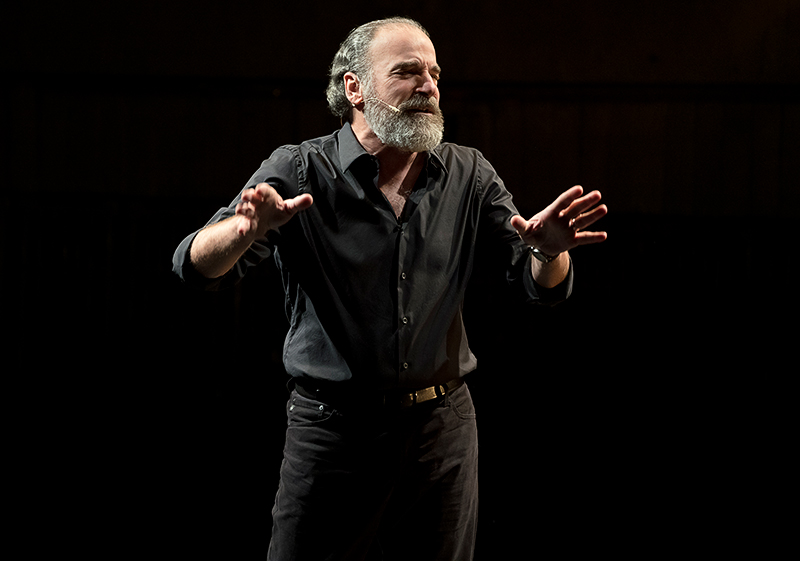Mandy Patinkin
By Jen Banowetz
October 2023 View more Spotlight
This Chicago-born performer brings his talents to the Mac

When it comes to swordplay, Mandy Patinkin does, in fact, fence better as a lefty—just like Inigo Montoya. Though it took months of training for the naturally right-handed Patinkin to swashbuckle like a southpaw.
Patinkin’s part as the avenging swordsman in 1987’s The Princess Bride is what he calls one of his top three “professional blessings.” Another is originating the Broadway role of Georges Seurat in Stephen Sondheim’s Sunday in the Park with George. But his favorite are his concerts, which have taken him all over the world for 30-plus years. Audiences can experience one firsthand when Patinkin and pianist Adam Ben-David take the stage at 7:30 p.m. October 12 and 14 at the McAninch Arts Center in Glen Ellyn.
Patinkin grew up on Chicago’s South Side, where his love for theater was sparked as a high school freshman in a production of Anything Goes at the Young Men’s Jewish Council center. We caught up with the Tony- and Emmy-winner to chat about his career.
Q: Tell us about your latest concert.
A: Of all the things I’m privileged to be able to do, there’s nothing as good as being on the stage with a live audience, all together, living the day that just took place. When you’re not with people, you miss a major part of being a human being, which is to interact with other human beings. I think we’re meant to experience life together.
These men and women who wrote these songs—I’m just the mailman—these are the real geniuses in my book that had the sensitivity, and in many cases the simplicity—like a Shakespeare or a Sondheim—to capture our lives in a way that tell stories. All my songs are stories; they make us want to hear them over and over and over again, and that’s why you can do them a thousand times but you never did it that day. What happened in the world that day? All of that feeds into how we listen to the lyrics. All these songs, you get to hear them a different way every day; they’re never, ever the same.
Q: You’ve also tackled film and TV. How do you compare those?
A: They’re all apples and oranges. They have almost nothing to do with each other, other than the fact that they are telling stories—that’s the common ground—and there are people sometimes pretending to be other people, sometimes pretending to be themselves, or just being themselves—but they are telling stories in general. But the methodology of telling the story is very different. They have different disciplines. If you do a movie, you only need to do the scene a few times that day within about a two- to three-hour period. You have to repeat it over and over again, but then you’re done. When you do a play, you do it for a four- to six- to eight-week rehearsal period and then you do it eight times a week for however long.
Q: Tell us about your experience in The Princess Bride.
A: I had the time of my life. You know, the first line said, “the world’s greatest sword fighter,” so it was like an athletic event. I went into training to become a sword fighter for six months. I trained with two Olympic fencers, and then we filmed for four or five months. And it was just the greatest. I mean I couldn’t believe they were paying me to do this. And then that [the film] became what it became over time.
Q: Do you have any advice to share?
A: If there’s a lesson that I’ve lived that I would offer to people, it’s: Don’t ever let anybody tell you that you can’t do something that you think you want to do. The worst mistake that you can make, in my humble opinion, is to never try. If you try and you fail, move on, but if you want to try to do something, please, please try it. You never know.
Q: What about failures?
A: We never learn anything from our successes—they pat you on your back, they hand you some kind of award, nobody remembers who got the award for the next year, and you move on. But the failures. When you fail at something, when it doesn’t go well, for whatever reason, you tear it apart, you look at it inside out and upside down if you care about it. You analyze it, you put it under the microscope of your being—and you learn, and you learn, and you learn. Without those failures that I’ve had in my life, those trials, those moments of tears in the corner, of thinking I can’t go through this anymore—without those moments of failure I haven’t a clue who I would have ever been.
Photo: Joan Marcus


